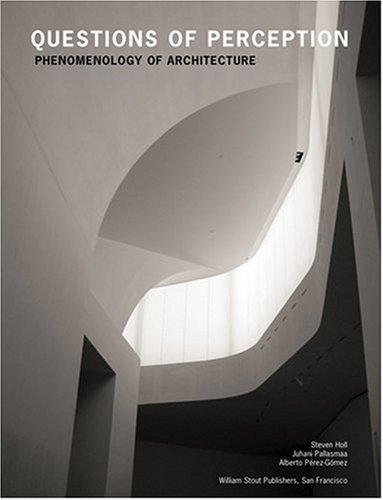Questions of Perception: Phenomenology of Architecture ebook download
Par wolfe lauren le dimanche, juillet 2 2017, 09:54 - Lien permanent
Questions of Perception: Phenomenology of Architecture. Steven Holl, Juhani Pallasmaa, Alberto Perez-Gomez

Questions.of.Perception.Phenomenology.of.Architecture.pdf
ISBN: 0974621471,9780974621470 | 155 pages | 4 Mb

Questions of Perception: Phenomenology of Architecture Steven Holl, Juhani Pallasmaa, Alberto Perez-Gomez
Publisher: William Stout
(2004), Open: New Designs for Public Space, Princeton Architectural Press; Holl, S. 'questions of space' - by bernard tschumi. Questions of Perception: Phenomenology of Architecture http://www.amazon.com/Questions-Perception-Phenomenology-Steven-Holl/dp/0974621471/ref=pd_sim_b_4. 'As a work of art or design that is created by an artist specifically to be sited in a public space,' (The Newport News Public Art Foundation) monuments, memorials and architectural ornamentation are all valid examples. Publication, but by far the most lucid and cogent of his writings. I believe I am already developing my own 'vision' of what I believe is architecture, but I still want to look more. The MIT Press: Cambridge, MA, 1960. I'm willing to bet maybe 3 people on archinect actually have this little book - came and went quick in the mid 90's. This summer, I really want to discover my place within the realms of architecture theory. This new edition of Questions of Perception brings back into print one of the most important architectural theory treatise of recent years. Questions of perception: phenomenology of architecture. In order to stop the alienation of architecture, we must strive towards a higher awareness of multi-sensory perception in contemporary architecture. Maurice Merleau-Ponty, Phenomenology of Perception. Steven Holl, Juhani Pallasmaa, and Alberto Perez-Gomez, Questions of Perception: Phenomenology of Architecture, 2nd ed (San Francisco: William Stout Publishers, 2006), p.29. (2006), Exhibition Design, Laurence King, London; Gastil, W., Ryan, Z. Such an analysis will employ phenomenological theories about the production and experience of architectural space.